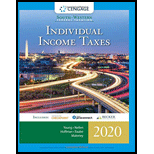
Kelly was promoted and received a substantial raise that includes compensation in the form of incentive stock options. She talks to her tax adviser about potential tax ramifications. After making some projections, her adviser welcomes her to the AMT club. Kelly is surprised to learn that her promotion will be rewarded with an additional tax in the form of the AMT. Explain to Kelly the purpose of the AMT and why it applies to her.
Explain the purpose of AMT and its application in Mrs K’s case.
Explanation of Solution
Alternative Minimum Tax (AMT): AMT is a tax system imposed by congress to collect a minimum amount of income tax for each year from the taxpayers who generated the income more than modest economics income. The AMT uses economic income as the tax base rather than the regular income tax base.
Purpose of AMT
- When the tax payer is uses alternate minimum tax, exclusions, deductions, and credits are used. This helps to reduce and eliminate the regular income tax liability of the tax payer.
- Secondly, Congress, the legislative body of Country U has a belief that some of the taxpayers who have substantial economic income take too much advantage of the minimization of the taxes and thus resulted in more inequality.
Thus, above two are the major reasons for enacting AMT.
Application of AMT
- Primarily, AMT was initiated to make sure that taxpayers who have uncertain economic income must also pay minimum tax. In the given case, K receives taxable income plus adjustments and preferences. She pays more state tax and has other investment alternatives. This results AMT consequences and thus, gets benefited out of the advantaged stock option compensation. Hence, K will incur AMT.
Want to see more full solutions like this?
Chapter 12 Solutions
Individual Income Taxes
- Don't use ai. A company has the following data: Cash: $50,000Accounts Receivable: $30,000Inventory: $60,000Current Liabilities: $70,000a) What is the company’s acid-test ratio?b) Is the company in a strong liquidity position based on this ratio?arrow_forwardQuestion 5:A company has the following data: Cash: $50,000Accounts Receivable: $30,000Inventory: $60,000Current Liabilities: $70,000a) What is the company’s acid-test ratio?b) Is the company in a strong liquidity position based on this ratio?arrow_forwardQuestion 5: Acid-Test RatioA company has the following data: Cash: $50,000Accounts Receivable: $30,000Inventory: $60,000Current Liabilities: $70,000a) What is the company’s acid-test ratio?b) Is the company in a strong liquidity position based on this ratio?arrow_forward
- Question 4: Depreciation (Straight-Line Method)A company purchases machinery for $50,000. The estimated salvage value is $5,000, and the useful life is 10 years. a) Calculate the annual depreciation expense.b) What will the book value of the machinery be after 4 years?arrow_forwardInventory Valuation (FIFO Method)A company had the following inventory transactions during the month: Beginning inventory: 100 units @ $10 eachPurchase: 200 units @ $12 eachPurchase: 150 units @ $13 eachAt the end of the month, 250 units remain in inventory. Calculate the value of the ending inventory using the FIFO method. explainarrow_forwardNeed assistance without use of ai.arrow_forward
- Depreciation (Straight-Line Method)A company purchases machinery for $50,000. The estimated salvage value is $5,000, and the useful life is 10 years. a) Calculate the annual depreciation expense.b) What will the book value of the machinery be after 4 years?arrow_forwardA company has the following data: Cash: $50,000Accounts Receivable: $30,000Inventory: $60,000Current Liabilities: $70,000a) What is the company’s acid-test ratio?b) Is the company in a strong liquidity position based on this ratio?arrow_forwardDon't want AI answerarrow_forward
 Individual Income TaxesAccountingISBN:9780357109731Author:HoffmanPublisher:CENGAGE LEARNING - CONSIGNMENT
Individual Income TaxesAccountingISBN:9780357109731Author:HoffmanPublisher:CENGAGE LEARNING - CONSIGNMENT





